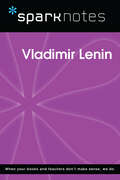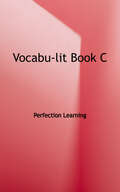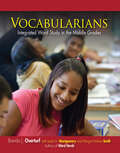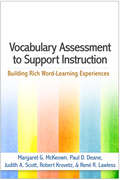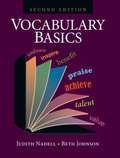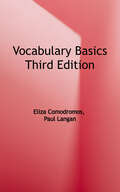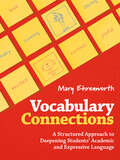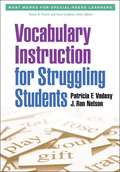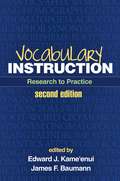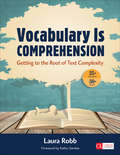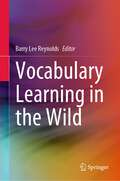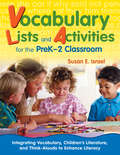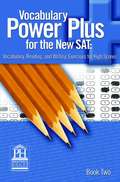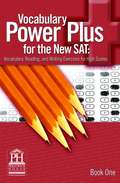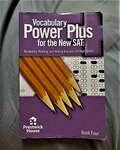- Table View
- List View
Vizhichaval monthly magazine February 2018
by RamaniArticle contributors by visually challenged and related to visually challanged
Vizhichaval monthly magazine january 2018
by RamaniArticle contributors by visually challenged and related to visually challanged
Vladimir Lenin (SparkNotes Biography Guide)
by SparkNotesVladimir Lenin (SparkNotes Biography Guide) Making the reading experience fun! SparkNotes Biography Guides examine the lives of historical luminaries, from Alexander the Great to Virginia Woolf. Each biography guide includes:An examination of the historical context in which the person lived A summary of the person&’s life and achievements A glossary of important terms, people, and events An in-depth look at the key epochs in the person&’s career Study questions and essay topics A review test Suggestions for further reading Whether you&’re a student of history or just a student cramming for a history exam, SparkNotes Biography guides are a reliable, thorough, and readable resource.
Vocabu-Lit, Book C: Building Vocabulary Through Literature
by PLC Editors StaffIn this literature-based vocabulary program, students first read a short, unabridged passage with 10 targeted vocabulary words. The students then complete six exercises that teach strategies and reinforce word meanings. After every 10 lessons students complete a review lesson. <p><p>Grade 3
Vocabularians: Integrated Word Study in the Middle Grades
by Brenda L. OverturfBuilding on the ideas developed in Word Nerds: Teaching All Students to Learn and Love Vocabulary , Brenda J. Overturf has updated and energized the recommended practices for middle grades students. Vocabularians is for any educator who wants to help young adolescents increase knowledge and competency with word study while bringing interest, motivation, and even joy to their learning. Brenda takes teachers and administrators inside three middle-level schools where educators are integrating vocabulary instruction across the curriculum. In rural, urban, and suburban settings, she highlights effective ways to develop students' vocabulary skills using art, music, games, technology, reading, writing, speaking, listening, and critical thinking. Vocabularians shows teachers of all content areas how to build word networks, flood the classroom environment with academic vocabulary, and incorporate the three word-solving strategies that researchers have found to be the most important-;teaching students how to use context; deciphering words by breaking down prefixes, suffixes, and root words; and using reference materials in authentic ways. By blending current research with real classroom experience and application, Brenda builds on her work with Margot Holmes Smith and Leslie Montgomery and offers an easy-to-implement, customized-to-middle-school resource that will improve instruction and assessment. As one featured seventh grader shared: Vocabulary helps you because the more you know words, the more fluent you can be in reading, the better you can read and write, and the better your writing sounds. There's always going to be a time when you have to sound professional, whether you're applying for a job or anything else. You're just going to have to know how to use a good vocabulary.-
Vocabulary Assessment to Support Instruction: Building Rich Word-Learning Experiences
by Margaret G. Mckeown Judith A. Scott Paul D. Deane René R. Lawless Robert KrovetzVocabulary development is essential for learning, but conventional vocabulary assessments lack the range and flexibility to support K–12 classroom teachers in making instructional decisions. Drawing on linguistics, educational psychology, and educational measurement, this book offers a fresh perspective on word learning and describes powerful, precise assessment strategies. Guidelines are presented for selecting which words to teach, evaluating the depth and richness of students' word knowledge and their ability to apply it in complex contexts, designing effective instructional practices, and using technology to create adaptive and scalable assessments. User-friendly features include sample test items, classroom examples, a glossary, and suggested print and online resources.
Vocabulary Basics
by Beth Johnson Judith NadellIt is important to have a strong vocabulary. Words can make you a better reader, speaker, thinker, and learner. By working with the chapters in this book, you will greatly add to your vocabulary--and to your life as well.
Vocabulary Basics, Third Edition
by Paul Langan Eliza ComodromosWords have power. They express our emotions, convey our ideas, articulate our opinions, and reveal our thoughts. Students without an expansive vocabulary are challenged when asked to do these tasks. Furthermore, weak vocabularies limit students' understanding of what they read and the clarity of what they write. Many teachers tell us that their students' vocabularies are inadequate for academic demands. Vocabulary Basics aims to correct this problem. In 30 chapters divided into five units, it teaches 240 important words and several word-learning strategies.
Vocabulary Connections: A Structured Approach to Deepening Students’ Academic and Expressive Language
by Mary EhrenworthIn this lively, student-centered work, Dr. Mary Ehrenworth presents a complete curriculum for vocabulary acquisition, one that can be embedded as a separate component or taught inside of any reading curriculum in grades 3–6.Your students will learn to collect and apply literary vocabulary. They will learn a repertoire of writing about reading strategies for deepening literary vocabulary, close reading, and literary conversations. They will dive into a study of etymology, cognates, and compound words, as well as a deep study of morphology. These word conscious learners—budding linguists—will become flexible word solvers and creators as they learn to collect and apply domain vocabulary and develop expertise in attending to varied and subtle context clues not only to acquire domain vocabulary, but to comprehend more complex nonfiction texts.Teachers will appreciate the student-centered, affirming, and inclusive pedagogy, the attention to multilingualism, the focus on transfer and independence, the solid core of undergirding research, the room for immersion and inquiry, and the tremendous impact on reading comprehension and criticality as well as vocabulary.With a thoughtful progression across Literary Vocabulary, Word Consciousness, and Domain Vocabulary, Ehrenworth offers dozens of use-tomorrow lessons designed to be easily replicated with multiple texts, in a variety of learning experiences. Specifically, Vocabulary Connections presents practical structures to help teachers develop replicable protocols for: collecting literary and domain vocabulary writing about reading as a way to deepen vocabulary and interpretation investigating word choice as a way of thinking about point of view exploring context clues in complex nonfiction building word consciousness - morphology, compound words, cognates Grounded in both inquiry and direct instruction and supported with a variety of engaging visuals and instructional tips, Vocabulary Connections will quickly become a trusted resource you’ll want to return to for planning and instruction year after year.
Vocabulary Enrichment Programme: Enhancing the Learning of Vocabulary in Children
by Victoria JoffeThis book helps to enhance the understanding and use of vocabulary in secondary school students and young adults. Specifically designed for older children and young adults with language and communication needs, this practical language programme was created by a specialist speech & language therapist with input from secondary school teachers and students. The Vocabulary Enrichments Programme: focuses on enhancing the understanding and expression of vocabulary and word meanings in students aged from 8 to 18 aims to create an awareness of how improved vocabulary knowledge can be used to enhance learning in school and social interactions in school and home environments encourages an awareness and interest in words and language, introduces the concept of words and meanings and identifies their role and use in language, communication and social interaction introduces the word map and explore the rich networks of information attached to each word, including the meanings and make up of words using root and base words, suffixes and prefixes, synonyms and antonyms, and the etymology (origins) of words focuses on themes taken from the National Curriculum, including living and non living organisms, planet Earth and the world, the human body, emotions, healthy living, and occupations enhances the understanding and use of figurative and idiomatic language as well as more compound and complex sentence structures introduces a range of cueing techniques to aid in word retrieval. This book provide effective strategies for word learning to encourage independent word learning skills. It teaches an effective, efficient and realistic use of the dictionary as a tool for word learning and explore the role of the thesaurus in enhancing oral and written work.
Vocabulary Instruction for Struggling Students
by Patricia F. Vadasy Patricia NelsonAddressing a key skill in reading, writing, and speaking, this comprehensive book is grounded in cutting-edge research on vocabulary development. It presents evidence-based instructional approaches for at-risk students, including English language learners and those with learning difficulties. Coverage ranges from storybook reading interventions for preschoolers to direct instruction and independent word-learning strategies for older students. Guidance is provided on using word lists effectively and understanding how word features influence learning. The book also reviews available vocabulary assessment tools and describes how to implement them in a response-to-intervention framework.
Vocabulary Instruction, Second Edition
by Edward Kame'Enui James F. BaumannThis highly regarded work brings together prominent authorities on vocabulary teaching and learning to provide a comprehensive yet concise guide to effective instruction. The book showcases practical ways to teach specific vocabulary words and word-learning strategies and create engaging, word-rich classrooms. Instructional activities and games for diverse learners are brought to life with detailed examples. Drawing on the most rigorous research available, the editors and contributors distill what PreK-8 teachers need to know and do to support all students' ongoing vocabulary growth and enjoyment of reading. New to This Edition Reflects the latest research and instructional practices. New section (five chapters) on pressing current issues in the field assessment, authentic reading experiences, English language learners, uses of multimedia tools, and the vocabularies of narrative and informational texts. Contributor panel expanded with additional leading researchers.
Vocabulary Is Comprehension: Getting to the Root of Text Complexity (Corwin Literacy)
by Laura J. RobbTackle students’ biggest barrier to complex text: word knowledge In our rush toward complex texts, somehow we forget to put a new systematic vocabulary plan in place. Luckily, Laura Robb provides that instructional plan in Vocabulary Is Comprehension. The best part? Laura’s plan takes just 10 to 15 minutes, and much of it is spent in partner and independent work so this is no “add on” to squeeze in. All materials are included. There are 35+ lessons paired with 50+ complex texts that: Cover academic vocabulary, figurative language, denotative and connotative meanings, and more Align with specific CCSS vocabulary and writing standards Include strategies for ELLs and developing readers, along with formative assessments
Vocabulary Is Comprehension: Getting to the Root of Text Complexity (Corwin Literacy)
by Laura J. RobbTackle students’ biggest barrier to complex text: word knowledge In our rush toward complex texts, somehow we forget to put a new systematic vocabulary plan in place. Luckily, Laura Robb provides that instructional plan in Vocabulary Is Comprehension. The best part? Laura’s plan takes just 10 to 15 minutes, and much of it is spent in partner and independent work so this is no “add on” to squeeze in. All materials are included. There are 35+ lessons paired with 50+ complex texts that: Cover academic vocabulary, figurative language, denotative and connotative meanings, and more Align with specific CCSS vocabulary and writing standards Include strategies for ELLs and developing readers, along with formative assessments
Vocabulary Learning in the Wild
by Barry Lee ReynoldsThis book provides a timely and valuable resource to explore second language vocabulary learning outside the formal language learning classroom. Rapidly evolving technology and the increasing impact of the global village have resulted in dramatic changes to and increased occasions for second language vocabulary learning. This book offers new and valuable insights into the radically different opportunities both the physical and digital wild provide for language learners to increase their vocabulary knowledge. Practical advice is also given on how second language teachers can integrate vocabulary learning in the wild into their formal classroom instruction. This collection of cutting-edge studies by international experts working within the fields of second language teaching and learning, second language acquisition, applied linguistics, informal language learning, and technology enhanced learning offers an essential resource for language teachers and researchers.The internet is a powerful source of incidental language learning, but this is only part of language learning in the wild. This excellent book shows the range of opportunities available for learning another language outside the classroom in this much neglected research area. --Paul Nation, Emeritus Professor, Victoria University of Wellington
Vocabulary Lists and Activities for the PreK-2 Classroom: Integrating Vocabulary, Children’s Literature, and Think-Alouds to Enhance Literacy
by Susan E. IsraelThis practical resource for building children's vocabulary and comprehension skills provides word lists, literature selections, writing prompts, and suggestions for read-alouds and think-alouds.
Vocabulary Poetry VI
by James A. ChapmanThis teacher's key accompanies the sold-separately Vocabulary VI and contains the student text with answers, teaching notes for effective teaching methods, ideas for testing student progress, and explanations for the Verbal Analogy exercises.
Vocabulary Power Plus for the New SAT
by Daniel A. ReedYour students will score higher on the SAT once they've used Prestwick House's Vocabulary Power Plus for the New SAT, the only program that addresses all of the revisions in the test without compromising the vocabulary studies students need. Each unit alternates focusing on the critical reading and essay portions of the test with questions focusing on sentence completion, reading comprehension, inference, essay, root practice, and more. Review units ensure your students will remember what they've learned.
Vocabulary Power Plus for the New SAT
by Daniel A. ReedBeginning in 2005, the SAT is implementing major revisions, including: New reading sections; Analogies removed; Multiple-Choice Grammar and Usage Questions; Modified Reading Questions.Vocabulary Power Plus for the New SAT addresses all of the revisions in the test without vocabulary studies. Students will benefit from: Focused prefix, suffix, and root practice; Challenging inference exercises; Detailed critical reading exercises; New SAT-style writing and grammar exercises. Recommended for grade 11
Vocabulary Power Plus for the New SAT: Vocabulary, Reading, Writing Exercises for High Scores, Book One
by Daniel A. Reed Paul MolikenVocabulary Power Plus for the New SAT addresses all of the revisions implemented by the SAT in 2005 in the test such as New reading sections, Analogies removed Multiple-Choice Grammar and Usage Questions, Modified Reading Questions, etc., without vocabulary studies.
Vocabulary Power Plus for the New SAT: Vocabulary, Reading, and Writing Exercises for High Scores
by Daniel A. ReedIn 2005, the SAT implemented major revisions, including: New reading sections Analogies removed Multiple-Choice Grammar and Usage Questions Modified Reading Questions. Vocabulary Power Plus for the New SAT addresses all of the revisions in the test without vocabulary studies. Students will benefit from: Focused prefix, suffix, and root practice Challenging inference exercises Detailed critical reading exercises New SAT-style writing and grammar exercises Recommended for grade 9. This book is a classroom student edition.
Vocabulary Power Plus for the new SAT
by Daniel A. ReedIntended for 12th grade. <P><P>Your students will score higher on the SAT once they've used Prestwick House's Vocabulary Power Plus for the New SAT, the only program that addresses all of the revisions in the test without compromising the vocabulary studies students need. Each unit alternates focusing on the critical reading and essay portions of the test with questions focusing on sentence completion, reading comprehension, inference, essay, root practice, and more. Review units ensure your students will remember what they've learned. <P><P>Why should you use Vocabulary Power Plus? You'll save time because you won't have to write vocabulary lessons from scratch. Reading passages similar to those on the SAT* help students learn words by examining their contexts. Multiple exercises reinforce the meanings of words to students, fostering long-term knowledge. Your students will learn more than 200 new words in each book. You'll tackle vocabulary instruction and test prep with one resource.
Vocabulary Spelling Poetry II
by James A. ChapmanMaster new vocabulary words and practice presenting poetry from Vocabulary, Spelling, and Poetry II. This text includes 28 Word Lists that each contain 20 spelling words and 10 vocabulary words with definitions that correspond with selections from the 8th grade literature text—Of Places. <p><p>These lists include exercises that help your child understand and apply spelling rules, use words in the correct context, and recognize homonyms, synonyms, and antonyms. <p><p>This new edition features additional exercises that involve higher-level thinking such as analyzing prefixes, suffixes, and roots, plus answering analogy questions related to the text. Increase your child’s credibility through correct spelling well-rounded vocabulary, and an appreciation of poetry.
Vocabulary Spelling Poetry III
by James A. ChapmanThis teacher's key accompanies the sold-separately Vocabulary, Spelling & Poetry III and contains a copy of the student text with answers and a sentence bank for vocabulary and spelling words.
Vocabulary Spelling Poetry III (Fifth Edition)
by James A ChapmanWatch your child enhance his vocabulary and memorize classic poems from Shakespeare, Longfellow, and more with Vocabulary, Spelling, Poetry III. This work-text includes 24 Word Lists and 4 Review Lists that each contain 20 spelling words and 10 vocabulary words with definitions that correspond with selections from the 9th grade literature text—Themes in Literature. These lists include exercises that help your child understand and apply spelling rules, use words in the correct context, and recognize synonyms and antonyms. Ten well-known poems are also included for recitation and memorization to enhance the appreciation of poetry.

